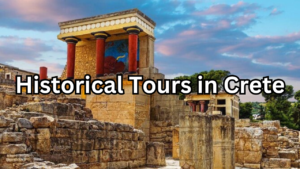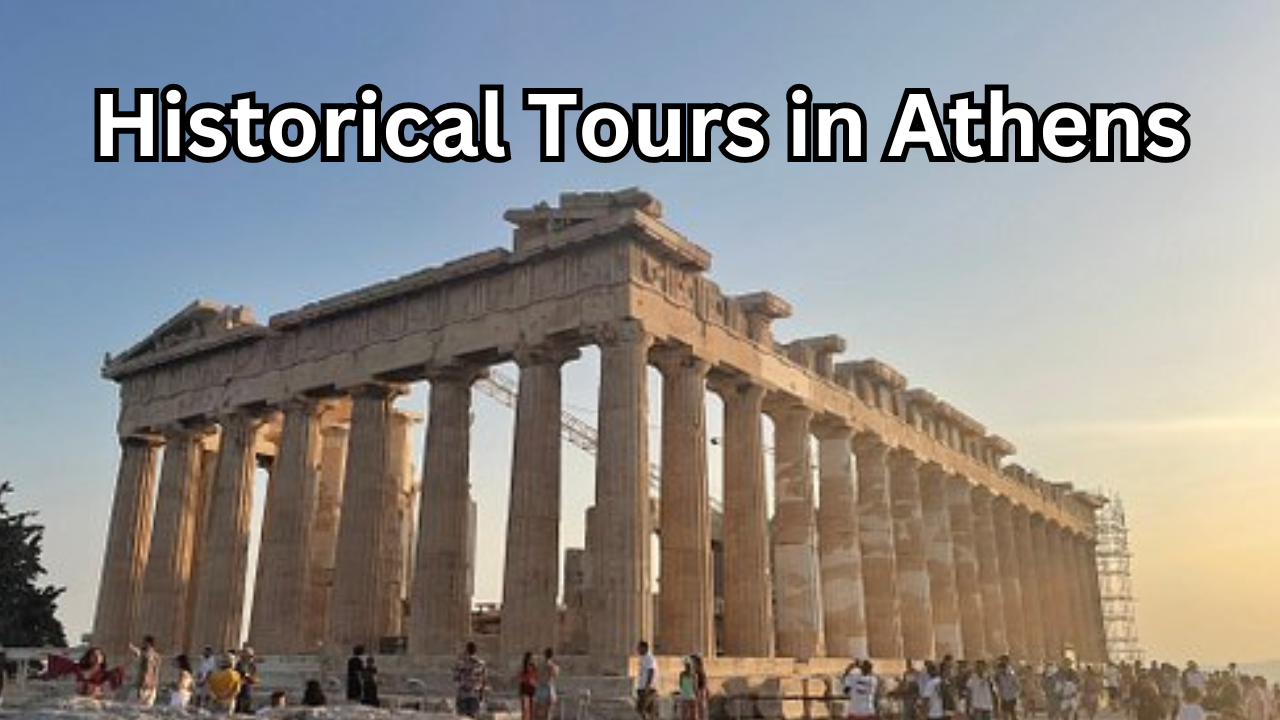
Table of Contents
Introduction
Athens, the cradle of Western civilization, stands as a living testament to millennia of history, culture, and innovation. Its ancient roots and classical legacy have drawn visitors from around the globe, eager to explore its historical wonders. One of the most immersive ways to experience Athens’ rich heritage is through a series of historical tours that unravel the city’s layers of history, from ancient Greek civilization to Byzantine and modern influences.
These historical tours in Athens offer a captivating journey through time, allowing travelers to walk in the footsteps of philosophers, warriors, and artists who shaped the course of history. Each tour is a curated experience, blending expert guidance with immersive exploration, bringing to life the stories and monuments that define Athens’ cultural tapestry.
From the majestic Acropolis overlooking the city to the bustling streets of Plaka and the treasures housed in the National Archaeological Museum, these tours offer a comprehensive glimpse into Athens’ past and present. Whether delving into the philosophical debates of the ancient Agora or savoring the flavors of traditional Greek cuisine, each tour offers a unique perspective on this historic city.
Join us on a journey through the historical tours of Athens, where every step is a discovery and every story a chapter in the epic narrative of one of the world’s most iconic cities.
Brief Overview of Athens’ Historical Significance:
Lets know about Athens in Europe stands as a beacon of history, renowned for its profound impact on Western civilization. As the birthplace of democracy, philosophy, and classical art and architecture, Athens holds a pivotal position in shaping the modern world. The city’s historical significance dates back thousands of years, marked by the achievements of great thinkers like Socrates, Plato, and Aristotle, as well as the architectural marvels of the Acropolis.
From the Golden Age of Pericles to the Byzantine era and beyond, Athens has endured and evolved, leaving behind a legacy of intellectual, cultural, and artistic achievements. Its ancient ruins, museums, and monuments serve as windows into this rich past, offering invaluable insights into the foundations of democracy, the birth of theatre, and the enduring legacy of Greek mythology.
Importance of Historical Tours in Understanding Athens’ Heritage:
Historical tours play a crucial role in unraveling Athens’ heritage by providing immersive experiences that go beyond textbooks and classrooms. These tours offer visitors the opportunity to walk amidst ancient ruins, to touch the stones that once echoed with the voices of philosophers and statesmen, and to connect with the spirit of a civilization that continues to influence the world.
By exploring Athens through guided tours, travelers gain a deeper understanding of the city’s historical, cultural, and architectural significance. They can appreciate the intricate details of ancient temples, decipher the symbolism in Greek art, and trace the evolution of Athenian society through the centuries.
Moreover, historical tours in Athens are not just about monuments and artifacts; they also showcase the city’s living heritage. From vibrant neighborhoods like Plaka to modern art galleries and culinary experiences, these tours highlight how Athens’ past and present intertwine, creating a dynamic tapestry of traditions, ideas, and innovations.
In essence, historical tours in Athens serve as bridges between the past and the present, offering a journey of discovery that enriches our understanding of history, heritage, and humanity.
Acropolis Tour
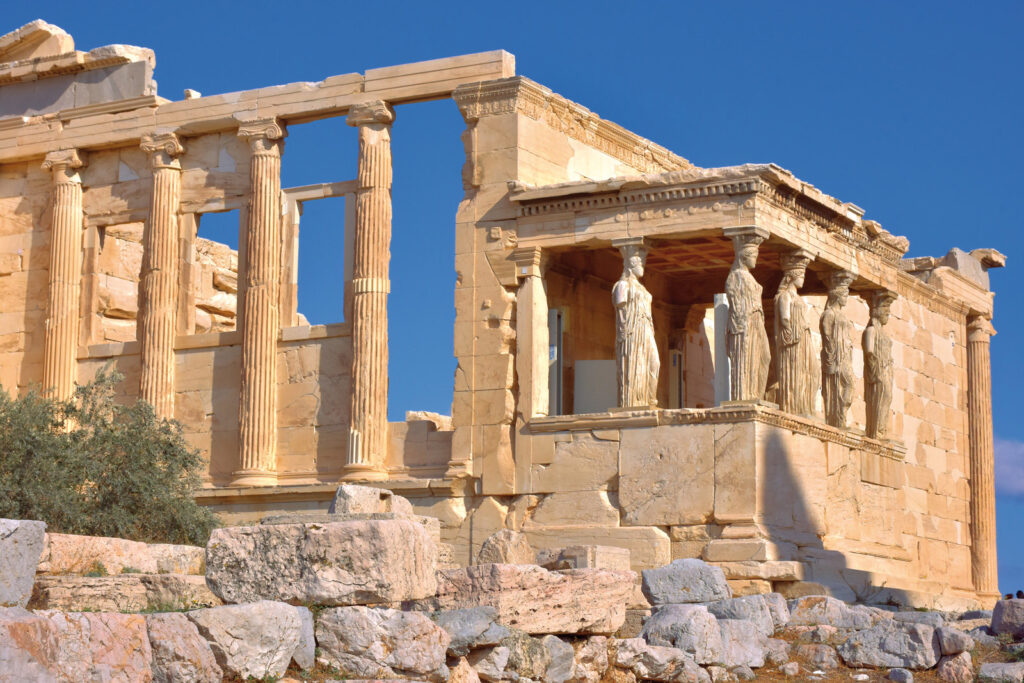
The Acropolis Tour is an awe-inspiring journey through the heart of ancient Athens, centered around the iconic Acropolis hill. This tour immerses visitors in the monumental achievements of ancient Greek civilization, showcasing masterpieces such as the Parthenon, Erechtheion, and Propylaea. Led by knowledgeable guides, the Acropolis Tour delves into the historical and cultural significance of each architectural marvel, revealing stories of gods and goddesses, myths and legends, and the birth of democracy. As visitors ascend the sacred rock of the Acropolis, they are transported back in time, marveling at the engineering feats and artistic brilliance that define this UNESCO World Heritage Site. The Acropolis Tour is not just a journey through ruins; it’s a testament to human ingenuity and creativity, leaving a lasting impression on all who experience its grandeur.
Description of the Acropolis and its iconic monuments (Parthenon, Erechtheion, Propylaea)
The Acropolis of Athens stands as a symbol of ancient Greek civilization’s zenith, perched atop a rocky outcrop overlooking the city. Its iconic monuments, including the Parthenon, Erechtheion, and Propylaea, showcase the pinnacle of classical architecture and artistic achievement. The Parthenon, dedicated to the goddess Athena, is a marvel of Doric architecture, adorned with intricate sculptures and friezes that narrate mythological tales. The Erechtheion, with its famous Caryatids, is a testament to the city’s religious reverence, housing sacred relics like the olive tree gifted by Athena. The Propylaea serves as the monumental gateway to the Acropolis, blending Doric and Ionic styles in its grandeur.
Guided tour highlighting the historical and cultural significance of each monument
Guided tours of the Acropolis offer a captivating journey into the historical and cultural significance of each monument. Visitors are led through the layers of history, from the mythical origins of Athena to the democratic ideals represented by these architectural wonders. Guides unravel the stories behind the Parthenon’s construction, the rituals held at the Erechtheion, and the strategic importance of the Propylaea in ancient times. Through engaging narratives and detailed explanations, the guided tour brings to life the splendor and legacy of the Acropolis, allowing visitors to appreciate not just its physical beauty but also its profound impact on Western civilization.
Ancient Agora Tour
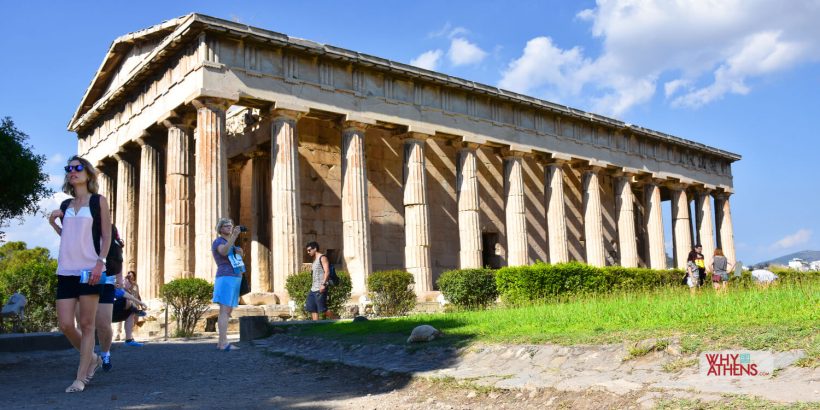
Embarking on an Ancient Agora Tour is like stepping into the bustling heart of ancient Athens, where the pulse of democracy, philosophy, and daily life once thrived. The Agora, a central marketplace and civic hub, was not just a place for commerce but also the epicenter of political debates, philosophical discourses, and cultural gatherings. During the tour, visitors traverse the same paths where Socrates engaged in dialogues, where Athenian citizens convened to make crucial decisions, and where the essence of Greek democracy took root.
Led by knowledgeable guides, the Ancient Agora Tour delves deep into the historical significance of this vibrant space. Visitors explore archaeological remnants such as the Stoa of Attalos, where merchants once traded goods, and the Temple of Hephaestus, a stunning example of Doric architecture dedicated to the god of craftsmanship. Guides illuminate the democratic principles that shaped ancient Athenian society, discussing the role of citizens in governance and the evolution of political ideologies.
Moreover, the Ancient Agora Tour offers insights into everyday life in ancient Athens, from the types of goods sold in the marketplace to the cultural activities and festivals that enlivened the city. By immersing visitors in the sights, sounds, and stories of the Agora, this tour provides a holistic understanding of Athenian history, culture, and civic life, making it a must-visit for anyone seeking to unravel the mysteries of the past.
Introduction to the Ancient Marketplace of Athens
The ancient marketplace of Athens, known as the Agora, holds a unique place in history as the bustling center of civic life and commerce in ancient Greece. This vibrant marketplace was more than just a venue for buying and selling goods; it was a dynamic hub where ideas were exchanged, political debates unfolded, and cultural activities flourished. The Agora served as the beating heart of Athens, where citizens gathered to participate in the democratic process, engage in philosophical discussions, and celebrate religious festivals.
Dating back to the 6th century BCE, the Agora evolved over the centuries to become a multifunctional space that reflected the values and aspirations of Athenian society. It housed a variety of structures, including stoas (covered walkways), temples, government buildings, and shops, each playing a distinct role in shaping the city’s identity. From the Stoa of Attalos, a monumental colonnade that housed shops and served as a meeting place, to the Temple of Hephaestus, a magnificent temple dedicated to the god of craftsmanship, the Agora’s architectural marvels were a testament to ancient Greek ingenuity and artistic prowess.
The Agora was not only a commercial center but also a place of intellectual and cultural exchange. Philosophers like Socrates and Plato frequented its open spaces, engaging in philosophical dialogues that challenged conventional wisdom and inspired new ways of thinking. The Agora also hosted theaters, religious ceremonies, and athletic competitions, reflecting the diverse interests and passions of Athenian citizens.
Today, exploring the ancient marketplace of Athens offers a fascinating glimpse into the city’s rich heritage. It allows visitors to walk in the footsteps of ancient Greeks, to imagine the vibrant scenes of daily life that once animated the Agora, and to appreciate its enduring legacy as a symbol of democratic ideals, intellectual curiosity, and artistic achievement.
Exploration of key sites within the Agora and their historical context
Exploring the key sites within the Agora unveils a tapestry of history, culture, and civic life that defined ancient Athens. Each site within this vibrant marketplace carries a unique historical context, shedding light on different aspects of Athenian society and its evolution over time.
One of the pivotal sites within the Agora is the Stoa of Attalos, a reconstructed colonnade that served as a commercial hub and meeting place. Originally built in the 2nd century BCE and reconstructed in the 1950s, the Stoa of Attalos provides insight into ancient trade practices, showcasing the bustling activity of merchants and artisans who gathered here to sell their goods and engage in business transactions. Its architectural grandeur also reflects the prosperity and civic pride of Athens during the Hellenistic period.
Adjacent to the Stoa of Attalos stands the Temple of Hephaestus, one of the best-preserved ancient Greek temples dedicated to the god of craftsmanship. Built in the 5th century BCE, this Doric temple exemplifies classical Greek architecture, with its sturdy columns, intricate friezes, and religious significance. The temple’s location within the Agora underscores the intersection of religious and civic life in ancient Athens, where ceremonies, rituals, and festivals played a vital role in community cohesion.
Further exploration of the Agora reveals the Bouleuterion, or Council House, where the Athenian councilors met to discuss political matters and make decisions affecting the city-state. This structure, dating back to the 5th century BCE, highlights the democratic principles of Athens, where citizens participated in governance and debated issues of public interest. The Bouleuterion’s layout and design offer insights into the functioning of Athenian democracy and the importance of civic engagement in ancient Greek society.
Additionally, the Odeon of Agrippa, a small theater within the Agora, speaks to the cultural life of Athens, showcasing performances, musical events, and theatrical productions that entertained and educated the populace. Its role as a center for artistic expression and communal gatherings underscores the significance of the Agora not only as a marketplace but also as a social and cultural nexus.
By exploring these key sites within the Agora and understanding their historical context, visitors gain a deeper appreciation for the multifaceted nature of ancient Athenian society. The Agora emerges as more than just a marketplace; it becomes a microcosm of democracy, commerce, religion, and culture, offering a comprehensive view of life in classical Athens.
Ancient Greek democracy, philosophy, and daily life
The exploration of the Agora extends beyond its physical structures to encompass the rich tapestry of topics that defined ancient Greek society. One of the central themes that emerge is the concept of democracy, a cornerstone of Athenian governance that profoundly influenced Western political thought. Within the Agora, visitors can delve into the workings of ancient Greek democracy, where citizens participated in decision-making processes, debated public policies, and upheld the ideals of equality and civic responsibility. The Agora served as a gathering place for political assemblies, where issues of governance, lawmaking, and administration were discussed, reflecting the democratic ethos that characterized Athens.
Philosophy also flourished within the Agora, with prominent thinkers such as Socrates, Plato, and Aristotle shaping intellectual discourse and philosophical inquiry. The Agora’s open spaces provided a forum for philosophical dialogues, debates, and teachings, where ideas about ethics, metaphysics, and the nature of knowledge were explored. Visitors can immerse themselves in the intellectual ferment of ancient Athens, tracing the footsteps of philosophers who challenged convention and sought wisdom amidst the bustling marketplace.
Moreover, the Agora offers glimpses into the daily life of ancient Athenians, from their social interactions and cultural practices to their economic pursuits and religious rituals. The marketplace was not only a center of commerce but also a social hub where people gathered to socialize, exchange news, and engage in recreational activities. Artisans, craftsmen, and traders plied their trades in the Agora, contributing to the city’s economic vitality and cultural diversity.
By focusing on topics such as ancient Greek democracy, philosophy, and daily life, the exploration of the Agora becomes a multidimensional journey through the layers of history, ideology, and human experience. It illuminates the interconnectedness of politics, philosophy, and society in ancient Athens, offering valuable insights into the foundations of Western civilization and the enduring legacy of ancient Greek thought.
Acropolis Museum Tour
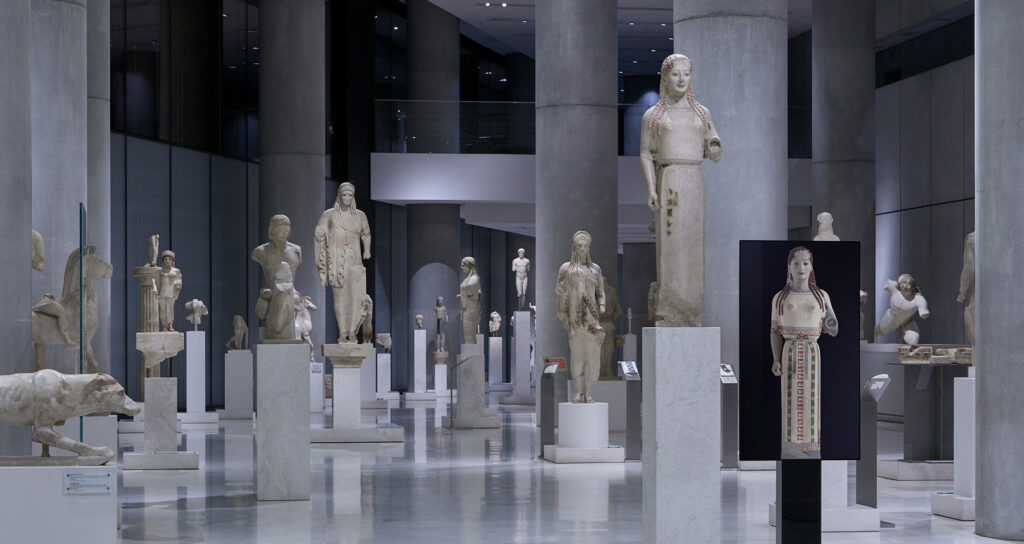
Embarking on an Acropolis Museum Tour is akin to embarking on a journey through the treasures of ancient Greece housed within a modern architectural marvel. Situated at the foot of the Acropolis hill, the museum is a testament to the rich cultural heritage of Athens and offers a comprehensive insight into the city’s illustrious past. The tour takes visitors on a chronological exploration, starting from the prehistoric era and progressing through the Archaic, Classical, Hellenistic, and Roman periods. Exhibits include exquisite sculptures, intricate pottery, intricate jewelry, and artifacts that span thousands of years, providing a vivid portrayal of ancient Greek art, craftsmanship, and daily life. The museum’s highlight is the Parthenon Gallery, where the friezes and sculptures from the Parthenon are displayed, offering a close-up view of the artistic mastery and narrative depth of these ancient masterpieces. Guided by knowledgeable experts, the Acropolis Museum Tour not only unveils the artistic achievements of ancient Greece but also delves into the historical contexts, cultural significance, and archaeological insights that enrich our understanding of this remarkable civilization.
Overview of the Acropolis Museum and its collection
The Acropolis Museum stands as a modern marvel nestled at the base of the historic Acropolis hill in Athens. This architectural gem serves as a beacon of Greece’s cultural heritage, housing a vast collection of artifacts that span several millennia. Designed by renowned architect Bernard Tschumi and opened to the public in 2009, the museum offers a state-of-the-art space that complements its ancient treasures. Its sleek glass facades and innovative layout create a harmonious blend of ancient and contemporary aesthetics, setting the stage for an immersive journey into Greece’s past.
Examination of artifacts dating back to the Greek Bronze Age
The Acropolis Museum’s collection is a treasure trove of artifacts dating back to the Greek Bronze Age, showcasing the evolution of Greek art, craftsmanship, and civilization. Visitors can marvel at intricately carved sculptures, delicate pottery, ornate jewelry, and architectural fragments that offer insights into daily life, religious practices, and artistic achievements of ancient Greeks. Noteworthy highlights include the sculptures from the Parthenon, Erechtheion, and Temple of Athena Nike, each telling a story of myth, history, and cultural identity. The museum’s dedication to preserving and showcasing these artifacts ensures that Greece’s rich heritage is accessible to present and future generations.
Importance of the museum in preserving and showcasing Athens’ history
The Acropolis Museum plays a pivotal role in preserving and showcasing Athens’ history, acting as a custodian of the city’s cultural legacy. By meticulously curating and displaying artifacts from various periods of Greek history, the museum offers a comprehensive narrative of Athens’ past, from its mythical origins to its golden age of democracy and intellectual flourishing. Beyond mere preservation, the museum serves as an educational resource, providing context, interpretation, and scholarly insights into the significance of each artifact and its relevance to Greek history and civilization. Its role as a cultural institution extends to promoting public awareness, fostering scholarly research, and fostering appreciation for Greece’s contributions to art, philosophy, and human civilization at large. In essence, the Acropolis Museum stands as a beacon of cultural heritage, bridging the gap between past and present, and enriching our understanding of Athens’ illustrious history.
Plaka Walking Tour
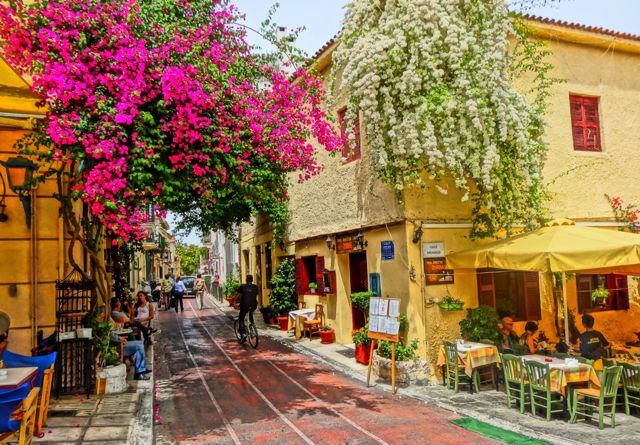
The Plaka Walking Tour offers a delightful journey through the oldest and most picturesque neighborhood in Athens, known as the “Neighborhood of the Gods.” Nestled beneath the northeastern slopes of the Acropolis, Plaka is a charming labyrinth of narrow streets, neoclassical architecture, and vibrant bougainvillea. This tour immerses visitors in the rich tapestry of Athens’ history, culture, and daily life, blending the ancient with the contemporary in a seamless and enchanting experience.
A highlight of the tour is the exploration of Plaka’s historical landmarks and architectural gems. Visitors can wander through the Anafiotika district, a quaint area with whitewashed houses reminiscent of a Cycladic island, built by settlers from Anafi in the 19th century. The tour also includes stops at significant sites such as the Tower of the Winds, an ancient timekeeping structure, and the Choragic Monument of Lysicrates, a striking example of ancient Greek architecture.
As visitors stroll through Plaka, they encounter a lively mix of traditional tavernas, artisanal shops, and bustling markets. The tour provides ample opportunities to savor authentic Greek cuisine, from freshly baked pastries to delectable souvlaki, and to browse for unique souvenirs, handmade jewelry, and local crafts. Guides share fascinating anecdotes and historical insights, bringing to life the stories of the people who have lived and thrived in this neighborhood over the centuries.
In addition to its historical and cultural attractions, the Plaka Walking Tour captures the essence of Athenian life. The neighborhood’s vibrant street scenes, friendly locals, and atmospheric charm create a warm and inviting ambiance. Whether it’s the sound of live bouzouki music wafting from a taverna, the aroma of freshly brewed Greek coffee, or the sight of children playing in the streets, Plaka offers a sensory-rich experience that embodies the spirit of Athens.
Ultimately, the Plaka Walking Tour is a journey through time and tradition, providing an intimate glimpse into the heart of Athens. It reveals the layers of history that have shaped this iconic neighborhood, while celebrating the lively and enduring culture that makes Plaka a beloved destination for both locals and visitors alike.
Introduction to Plaka as the Oldest Neighborhood in Athens
Plaka, often referred to as the “Neighborhood of the Gods,” is the oldest and most historically rich district in Athens. Nestled beneath the shadow of the Acropolis, Plaka’s origins date back to ancient times, making it a living museum of Athens’ long and storied past. This enchanting area has retained its charm and character through centuries of change, offering a unique blend of ancient history and modern vitality. Walking through Plaka’s narrow, winding streets, visitors can feel the echoes of the past, from classical antiquity through Byzantine and Ottoman periods, each leaving its mark on this timeless neighborhood.
Exploration of Plaka’s Neoclassical Architecture, Shops, and Tavernas
Plaka is renowned for its stunning neoclassical architecture, a testament to its 19th-century revival. The neighborhood is dotted with beautifully preserved mansions and homes, characterized by their elegant facades, intricate balconies, and vibrant colors. As visitors wander through its labyrinthine streets, they encounter a delightful array of shops and boutiques offering everything from handcrafted jewelry and local art to traditional Greek souvenirs. Plaka is also famous for its tavernas and cafes, where one can savor the flavors of authentic Greek cuisine. From family-run establishments serving moussaka and souvlaki to cozy cafes offering fresh pastries and Greek coffee, the culinary experiences in Plaka are as diverse as they are delicious.
Immersion in the Local Culture and Atmosphere of Plaka
Immersing oneself in Plaka means engaging with the vibrant local culture and embracing the neighborhood’s unique atmosphere. The air is filled with the sounds of street musicians playing traditional bouzouki music, creating a lively and welcoming environment. Festivals and street performances are common, adding to the festive ambiance. The warmth of the local people, always eager to share stories and traditions, enhances the experience, making visitors feel at home. Plaka’s blend of history, culture, and community creates an atmosphere that is both dynamic and nostalgic, offering a true taste of Athenian life. Whether it’s exploring ancient ruins, shopping for unique treasures, or enjoying a leisurely meal in a taverna, Plaka provides a rich and immersive experience that captures the heart and soul of Athens.
National Archaeological Museum Tour
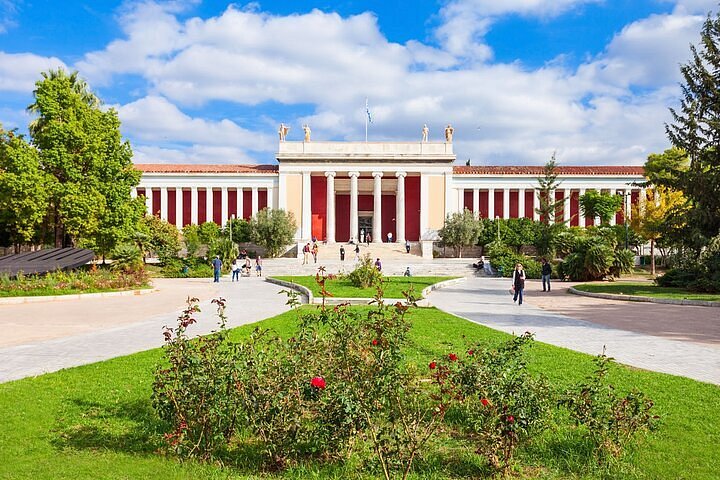
The National Archaeological Museum Tour offers a fascinating deep dive into Greece’s rich and ancient heritage, presenting one of the world’s most extensive and significant collections of Greek antiquities. As visitors step into the grand halls of the museum, they are greeted by a vast array of artifacts that span from the prehistoric era to late antiquity, each piece meticulously curated to narrate the story of Greek civilization through the ages.
A key highlight of the tour is the museum’s collection of sculptures, which includes iconic masterpieces such as the statue of Poseidon from the Artemision Bronze and the Jockey of Artemision. These sculptures, crafted by masterful ancient artists, provide insight into the artistic prowess and technological advancements of the time. The tour also delves into the rich funerary traditions of ancient Greece, showcased through exquisite grave stelae and funerary masks, including the famed gold Mask of Agamemnon.
The museum’s vast pottery collection is another focal point, featuring intricately decorated vases and ceramics that illustrate everyday life, mythology, and religious practices of the ancient Greeks. From the geometric designs of early pottery to the elaborate red-figure and black-figure techniques, each piece serves as a visual narrative of the society that created it.
In addition to these artistic treasures, the tour includes a comprehensive look at the museum’s impressive array of artifacts from the Greek Bronze Age. Items from the Minoan, Mycenaean, and Cycladic civilizations, such as frescoes, tools, and jewelry, provide a glimpse into the daily lives, beliefs, and advancements of these early cultures. The collection of Cycladic figurines, in particular, stands out for its abstract beauty and mysterious origins, offering a unique perspective on early Aegean art.
The National Archaeological Museum Tour is not just a journey through objects but a profound educational experience that highlights the importance of preserving and understanding Greece’s historical and cultural legacy. By showcasing these invaluable artifacts, the museum plays a crucial role in connecting the present with the past, allowing visitors to appreciate the enduring impact of ancient Greek civilization on the world today.
Description of the National Archaeological Museum’s Extensive Collection
The National Archaeological Museum in Athens boasts an extensive and unparalleled collection of artifacts, providing a comprehensive overview of Greek history and culture from prehistoric times to late antiquity. As Greece’s largest archaeological museum, it houses over 11,000 exhibits that span several millennia, showcasing the artistic, cultural, and technological achievements of ancient Greek civilization. The collection is organized into various sections, each dedicated to a different period or type of artifact, including sculptures, pottery, metalwork, frescoes, and everyday items. This meticulous curation allows visitors to trace the evolution of Greek art and society through the ages, gaining insight into the daily lives, religious practices, and monumental achievements of one of history’s most influential civilizations.
Highlights of Ancient Greek Artifacts Housed in the Museum
The museum’s collection includes some of the most iconic and significant artifacts from ancient Greece. Among the highlights are:
- The Mask of Agamemnon: This gold funeral mask, discovered by Heinrich Schliemann at Mycenae, is a stunning example of Mycenaean craftsmanship and a symbol of ancient Greek funerary practices.
- The Artemision Bronze: A powerful statue of either Zeus or Poseidon, this bronze masterpiece is remarkable for its dynamic pose and detailed craftsmanship, exemplifying the skill of ancient Greek sculptors.
- The Jockey of Artemision: This bronze statue of a young jockey riding a horse, dating back to the Hellenistic period, captures a sense of movement and vitality that is rare in ancient art.
- The Cycladic Figurines: These minimalist marble figurines from the Cycladic civilization are notable for their abstract beauty and simplicity, offering a glimpse into early Aegean art.
- The Thera Frescoes: These vibrant wall paintings from the island of Santorini depict scenes of nature and daily life, providing valuable insights into the Minoan civilization.
Significance of the Museum in Understanding Greece’s Archaeological Heritage
The National Archaeological Museum plays a crucial role in preserving and showcasing Greece’s rich archaeological heritage. It serves as a vital educational resource, offering scholars and the general public access to a vast array of artifacts that illuminate the complexities of ancient Greek society. By presenting these artifacts within their historical and cultural contexts, the museum fosters a deeper understanding of Greece’s past and its contributions to global heritage. Furthermore, the museum’s efforts in conservation and research ensure that these invaluable pieces of history are preserved for future generations. In essence, the National Archaeological Museum is not only a repository of ancient treasures but also a beacon of knowledge, celebrating and perpetuating the legacy of ancient Greece.
Byzantine Athens Tour
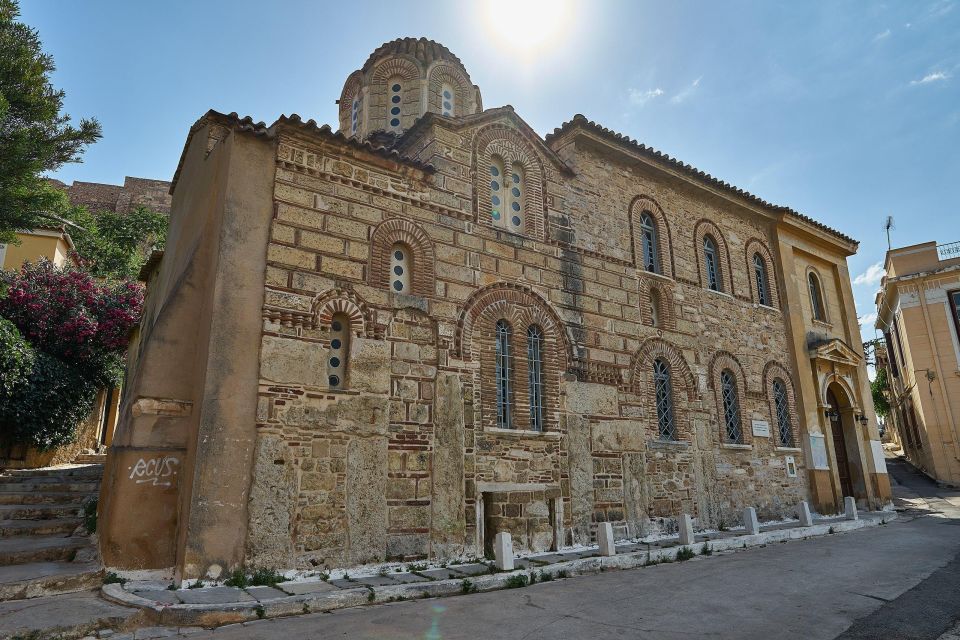
The Byzantine Athens Tour offers an enchanting journey through a lesser-known yet profoundly significant chapter of Athens’ history. While the city’s ancient Greek and classical heritage often dominate the spotlight, Athens’ Byzantine period is rich with cultural and historical treasures that provide a unique and captivating experience for visitors. This tour delves into the transformation of Athens from a classical city into a center of Byzantine culture and Orthodox Christianity, showcasing the architectural, artistic, and religious developments that defined this era.
One of the highlights of the Byzantine Athens Tour is the exploration of the city’s exquisite Byzantine churches, many of which are tucked away in quiet corners and bustling neighborhoods. These churches, adorned with intricate frescoes, mosaics, and iconography, reflect the spiritual and artistic achievements of the Byzantine period. Notable examples include the Kapnikarea Church, an 11th-century gem located in the heart of the modern city, and the Church of the Holy Apostles in the Ancient Agora, which beautifully illustrates the blend of classical and Byzantine architectural elements.
The tour also includes a visit to the Byzantine and Christian Museum, home to one of the world’s most important collections of Byzantine art and artifacts. Here, visitors can admire a wide array of icons, manuscripts, textiles, and liturgical objects that offer deep insights into Byzantine religious practices and daily life. The museum’s exhibits trace the evolution of Byzantine art from its early Christian roots to its mature, highly stylized forms, providing a comprehensive overview of this influential period.
In addition to its architectural and artistic highlights, the Byzantine Athens Tour immerses visitors in the historical context of the era. Guides share stories of the city’s resilience and adaptation through periods of conquest and change, from the rise of the Byzantine Empire to its eventual decline. The tour reveals how Athens maintained its cultural and religious significance, serving as a vital link between the ancient and medieval worlds.
Ultimately, the Byzantine Athens Tour enriches our understanding of Athens’ multifaceted history. It sheds light on the city’s Byzantine legacy, often overshadowed by its classical past, and highlights the enduring influence of Byzantine art, architecture, and spirituality. This tour offers a unique perspective on Athens, celebrating the city’s dynamic and continuous evolution through the ages.
Overview of Byzantine Athens and Its Historical Legacy
Byzantine Athens represents a fascinating era in the city’s long history, spanning from the 4th to the 15th centuries. During this period, Athens transitioned from its ancient Greek roots into a prominent center of Orthodox Christianity and Byzantine culture. The city’s transformation began in the early Byzantine era, marked by the construction of churches and religious monuments that reflected the growing influence of Christianity. Despite periods of decline and foreign invasions, Athens maintained its cultural and spiritual significance. The Byzantine period left an indelible mark on the city, evident in its enduring architectural and artistic heritage, which continues to captivate visitors and scholars alike.
Visit to Byzantine Churches Such as Agia Irini and Agios Eleftherios
The Byzantine Athens Tour includes visits to some of the city’s most beautiful and historically significant Byzantine churches. Agia Irini, located near Monastiraki Square, is one of the oldest churches in Athens, originally built in the 4th century and later reconstructed. This church exemplifies Byzantine ecclesiastical architecture with its domed structure and intricate mosaics. Another highlight is Agios Eleftherios, also known as the Little Cathedral, situated adjacent to the Metropolitan Cathedral of Athens. Built in the 12th century, Agios Eleftherios is renowned for its ornate carvings and well-preserved frescoes, which offer a glimpse into the artistic and religious fervor of the Byzantine era. Visiting these churches allows one to experience the spiritual ambiance and architectural splendor that characterize Byzantine Athens.
Exploration of Byzantine Art and Architecture in Athens
The tour also delves into the rich artistic and architectural legacy of Byzantine Athens. Byzantine art is renowned for its religious iconography, intricate mosaics, and vivid frescoes, all of which are abundantly represented in the city’s churches and museums. The Byzantine and Christian Museum, for instance, houses an extensive collection of icons, manuscripts, and liturgical objects that illustrate the evolution of Byzantine artistic styles and techniques. Architectural exploration includes studying the distinctive features of Byzantine church design, such as cross-in-square plans, domes, and elaborate decorative elements. These artistic and architectural treasures not only reflect the religious devotion of the Byzantine period but also highlight the technical and creative achievements of Byzantine artisans. Through this exploration, visitors gain a deeper appreciation for the cultural and historical significance of Byzantine art and architecture in Athens.
Athens Food Tour

The Athens Food Tour offers a delightful culinary journey through the heart of the city, allowing visitors to savor the rich and diverse flavors of Greek cuisine. This gastronomic adventure takes participants to bustling markets, traditional tavernas, and hidden culinary gems, providing a comprehensive taste of Athens’ vibrant food scene. Starting at the Central Market, known as Varvakios Agora, visitors experience the lively atmosphere where locals shop for fresh produce, meats, and seafood. The tour includes stops at local eateries where one can sample iconic Greek dishes such as souvlaki, moussaka, and spanakopita, as well as lesser-known regional specialties. Along the way, knowledgeable guides share stories and insights into the history, ingredients, and cultural significance of each dish. From sipping Greek coffee at a cozy kafeneio to indulging in sweet baklava, the Athens Food Tour not only satisfies the palate but also offers an immersive experience into the culinary traditions and hospitality of Greece.
Introduction to the Culinary Delights of Athens
Athens is a gastronomic paradise, where the rich flavors of traditional Greek cuisine come to life in a vibrant and dynamic food scene. The city’s culinary delights are deeply rooted in its history and geography, combining fresh, local ingredients with time-honored recipes that have been passed down through generations. From bustling markets filled with colorful produce to cozy tavernas serving up family recipes, the culinary landscape of Athens offers a mouthwatering array of flavors and textures. Whether it’s the tangy taste of tzatziki, the succulent savoriness of slow-cooked lamb, or the sweet, flaky layers of baklava, Athens provides an unforgettable food experience that reflects the heart and soul of Greek culture.
Sampling Traditional Greek Dishes at Local Eateries
One of the highlights of exploring Athens’ culinary scene is the opportunity to sample traditional Greek dishes at local eateries. Visitors can indulge in a variety of authentic foods, each representing the diverse regional flavors of Greece. Start with classic appetizers like dolmades (stuffed grape leaves) and creamy fava (yellow split pea dip), before moving on to hearty mains such as moussaka, a layered casserole of eggplant, minced meat, and béchamel sauce. Street food favorites like souvlaki and gyros offer quick yet delicious bites, while seafood lovers can enjoy freshly grilled octopus and marinated anchovies. The food tour typically includes visits to beloved local establishments where chefs and restaurateurs share the secrets behind their culinary creations, making the experience both educational and delicious.
Insight into the Cultural Importance of Food in Greek Society
Food holds a central place in Greek society, serving as a cornerstone of social and family life. Meals are often communal, bringing people together to share not just food, but also stories, laughter, and traditions. This cultural importance of food is evident in the way Greeks celebrate their cuisine, with a strong emphasis on hospitality and the joy of eating together. Each dish tells a story of the land, the sea, and the people who have cultivated and crafted it. Traditional recipes are cherished and meticulously preserved, reflecting a deep respect for heritage and history. Through the Athens Food Tour, visitors gain a profound appreciation for how food is intertwined with Greek identity, symbolizing community, connection, and a zest for life.
Athens Street Art Tour
The Athens Street Art Tour offers a vibrant and contemporary exploration of the city’s urban art scene, showcasing a kaleidoscope of colors, creativity, and cultural expression. As participants navigate through the streets and alleys of Athens, they encounter a diverse range of street art forms, from colorful murals and graffiti to stencil art and installations. Each artwork tells a unique story, reflecting the social, political, and cultural narratives of modern-day Athens. The tour provides insights into the city’s thriving street art culture, highlighting the work of both local and international artists who use the urban canvas to make bold statements, provoke thought, and engage with the public. From the vibrant neighborhoods of Psiri and Exarchia to the historical backdrop of Plaka, the Athens Street Art Tour offers a dynamic and visually captivating experience that showcases the city’s contemporary artistic spirit.
Description of Athens’ Vibrant Street Art Scene
Athens boasts a vibrant and dynamic street art scene that adds a splash of color and creativity to its urban landscape. From the bustling neighborhoods to the quiet alleys, the city serves as an open-air gallery showcasing a diverse array of street art forms. Vibrant murals, intricate graffiti, stencil art, and thought-provoking installations adorn the walls, buildings, and public spaces, turning Athens into a canvas for artistic expression. The street art scene reflects the city’s ever-evolving cultural landscape, with artists drawing inspiration from history, politics, mythology, and everyday life to create visually striking and meaningful artworks.
Guided Tour Showcasing Murals and Graffiti Artworks
The Athens Street Art Tour offers a guided exploration of the city’s vibrant street art, providing participants with a curated experience of discovering hidden gems and iconic artworks. Led by knowledgeable guides who are immersed in the local art scene, the tour takes visitors on a journey through diverse neighborhoods, revealing the stories and meanings behind the murals and graffiti. Participants have the opportunity to admire the skill and creativity of both established and emerging artists, whose works range from large-scale murals that dominate entire walls to smaller, intricate pieces that require a keen eye to discover. The guided tour not only showcases the artistic talent of Athens but also fosters an understanding of the messages, themes, and techniques that define the city’s street art culture.
Discussion of the Role of Street Art in Reflecting Modern Athenian Culture
Street art plays a significant role in reflecting the pulse and spirit of modern Athenian culture. It serves as a platform for artists to express their views, opinions, and emotions on a wide range of topics, from social issues and environmental concerns to cultural heritage and urban identity. The Athens Street Art Tour encourages discussions about the evolving role of street art in shaping public discourse, engaging communities, and challenging perceptions. Participants gain insights into how street art intersects with politics, activism, and cultural heritage, offering alternative perspectives and contributing to the dialogue on contemporary Athenian society. By exploring the city’s vibrant street art scene, the tour provides a deeper appreciation for the artistic diversity, cultural vibrancy, and creative energy that define modern-day Athens.
Cape Sounion Sunset Tour
Embarking on a Cape Sounion Sunset Tour is like stepping into a painting where nature’s beauty and ancient history blend seamlessly. Located at the southernmost tip of the Attica Peninsula, Cape Sounion is home to the iconic Temple of Poseidon, a majestic ancient structure overlooking the azure waters of the Aegean Sea. The tour begins with a scenic drive along the coastal road, offering breathtaking views of the Saronic Gulf and the rugged coastline. As the sun begins its descent, casting a golden glow over the landscape, visitors arrive at Cape Sounion to witness one of Greece’s most spectacular sunsets.
The highlight of the tour is the visit to the Temple of Poseidon, a Doric masterpiece dedicated to the god of the sea. Perched atop a cliff, the temple commands panoramic vistas of the surrounding seascape, making it a prime spot to watch the sunset unfold. Visitors have the opportunity to explore the ancient ruins, marveling at the impressive columns, intricate carvings, and timeless beauty of this archaeological gem. As the sun dips below the horizon, casting hues of orange, pink, and gold across the sky, the atmosphere becomes magical, evoking a sense of wonder and awe.
The Cape Sounion Sunset Tour not only offers a mesmerizing natural spectacle but also provides insights into ancient Greek mythology and history. Guides share fascinating stories about Poseidon, the god of the sea, and the significance of Cape Sounion as a sacred site and strategic lookout in antiquity. Visitors can immerse themselves in the aura of ancient Greece, imagining the temple’s former glory and the maritime legends that once echoed along these shores.
As the sun sets and the sky darkens, the tour concludes with a tranquil moment of reflection, allowing participants to absorb the beauty of the natural surroundings and the timeless allure of Cape Sounion. Whether capturing stunning photographs, enjoying a quiet moment of contemplation, or simply basking in the serenity of the evening, the Cape Sounion Sunset Tour offers a memorable and enchanting experience that captures the essence of Greece’s ancient past and natural splendor.
Overview of Cape Sounion and Its Historical Significance
Cape Sounion, situated at the southernmost tip of the Attica Peninsula, holds immense historical and mythological significance in Greek history. Dominated by the imposing Temple of Poseidon, this promontory overlooks the Aegean Sea and has served as a strategic landmark since ancient times. The Temple of Poseidon, a Doric marvel dating back to the 5th century BCE, was dedicated to the sea god Poseidon, making Cape Sounion a revered religious site and a symbol of maritime power. Its strategic location also made it a crucial point for maritime navigation and defense, with legends and historical accounts intertwining to create a rich tapestry of cultural heritage at Cape Sounion.
Scenic Drive Along the Athenian Riviera to Cape Sounion
The Cape Sounion Sunset Tour begins with a scenic drive along the breathtaking Athenian Riviera, offering panoramic views of the azure waters of the Saronic Gulf. The coastal road winds past picturesque seaside towns, sandy beaches, and rugged cliffs, creating a picturesque backdrop for the journey to Cape Sounion. Along the way, visitors can marvel at the natural beauty of the coastline, dotted with charming fishing villages, luxury resorts, and historic landmarks. The drive serves as a prelude to the awe-inspiring spectacle awaiting at Cape Sounion, enhancing the overall experience of the tour.
Watching a Breathtaking Sunset Over the Temple of Poseidon
The highlight of the Cape Sounion Sunset Tour is undoubtedly the opportunity to witness a breathtaking sunset over the Temple of Poseidon. As visitors arrive at Cape Sounion, they are greeted by the majestic silhouette of the ancient temple perched atop the cliff, with panoramic views of the Aegean Sea stretching into the horizon. As the sun begins its descent, casting a warm golden glow over the landscape, the atmosphere becomes magical and ethereal. The changing colors of the sky, from vibrant oranges to soft pinks and deep purples, create a stunning backdrop for the ancient ruins, transforming Cape Sounion into a scene of unparalleled beauty. Watching the sunset at Cape Sounion is not just a visual spectacle but a transcendent experience that connects visitors with the natural wonders and timeless allure of Greece’s ancient past.
Day Trip to Delphi
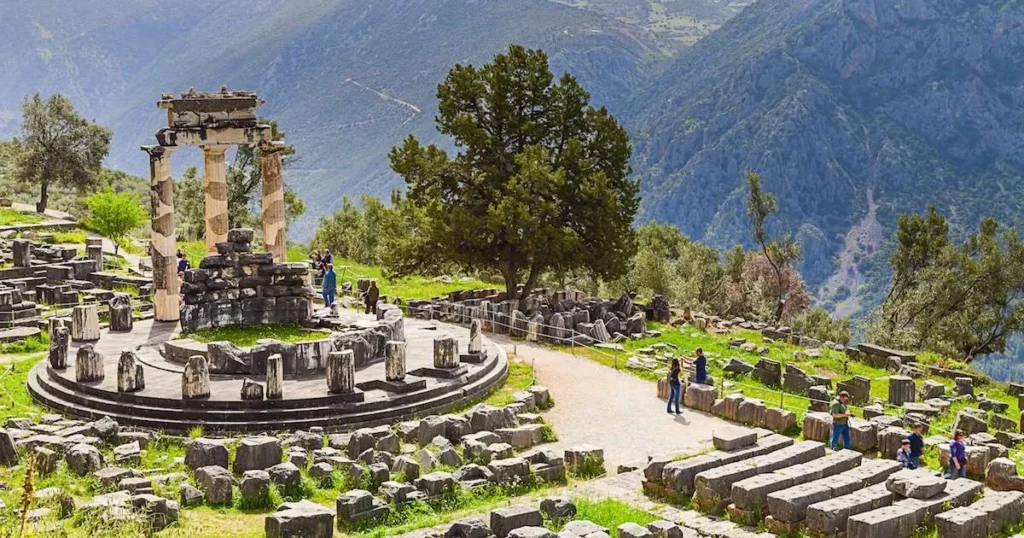
A day trip to Delphi is a journey into the heart of ancient Greece, offering a captivating blend of history, mythology, and natural beauty. Situated on the slopes of Mount Parnassus, Delphi was once considered the center of the world in Greek mythology and served as the sanctuary of Apollo, the god of prophecy. The tour begins with a scenic drive through the picturesque countryside of central Greece, passing olive groves, vineyards, and traditional villages. Upon arrival in Delphi, visitors are greeted by the stunning landscape of rugged mountains and lush valleys, creating a dramatic backdrop for the archaeological site.
The highlight of the day trip is the exploration of the ancient ruins of Delphi, including the well-preserved Temple of Apollo, the imposing Theater, and the intricate Treasury of the Athenians. Guides provide fascinating insights into the history and significance of each monument, bringing to life the myths and legends associated with Delphi. Visitors can also visit the Delphi Archaeological Museum, home to a remarkable collection of artifacts, including the famous Charioteer statue and the Omphalos stone.
In addition to its archaeological wonders, Delphi offers panoramic views of the surrounding landscape, with vantage points such as the Sanctuary of Athena Pronaia providing breathtaking vistas of the Corinthian Gulf and the olive groves below. The day trip allows for leisurely exploration, with time to wander through the Sacred Way, visit the ancient stadium, and soak in the serene ambiance of this historic site.
The day culminates in a sense of awe and wonder as visitors reflect on the profound significance of Delphi in ancient Greek history and culture. Whether admiring the majestic ruins, contemplating the Oracle’s predictions, or simply enjoying the tranquility of the mountainous setting, a day trip to Delphi offers a memorable and enriching experience that resonates with the timeless legacy of ancient Greece.
Introduction to Delphi as a UNESCO World Heritage Site
Delphi, nestled on the slopes of Mount Parnassus in central Greece, holds the prestigious title of a UNESCO World Heritage Site. Revered in antiquity as the “navel of the world,” Delphi’s archaeological remains and natural beauty have earned it this recognition. The site encompasses a complex of ancient structures, including the Temple of Apollo, the Theater, and the Sanctuary of Athena Pronaia, all set against a backdrop of stunning mountainous landscapes. Delphi’s inclusion as a UNESCO site acknowledges its profound historical, cultural, and archaeological significance, inviting visitors to explore the mysteries and marvels of this ancient sanctuary.
Exploration of the Ancient Sanctuary of Apollo and the Oracle of Delphi
The day trip to Delphi offers an immersive exploration of its ancient sanctuary dedicated to Apollo, the god of prophecy. The tour guides visitors through the sacred precincts, where pilgrims once sought answers from the renowned Oracle of Delphi. Highlights include the imposing Temple of Apollo, where the Oracle delivered her prophetic messages, and the intricately designed Tholos of Delphi, a circular building with symbolic significance. The tour also delves into the rituals and ceremonies that took place at Delphi, shedding light on the religious practices and beliefs of ancient Greeks.
Significance of Delphi in Ancient Greek History and Mythology
Delphi occupies a central place in ancient Greek history and mythology, symbolizing the intersection of the divine and the mortal realms. According to myth, Delphi was determined by Zeus to be the center of the earth, marked by the sacred Omphalos stone. It was here that Apollo established his sanctuary and where the Oracle, believed to channel Apollo’s wisdom, delivered cryptic prophecies to seekers from across the ancient world. Delphi’s influence extended beyond religion, playing a pivotal role in politics, art, and culture, as evidenced by the treasuries, monuments, and artworks dedicated by city-states and individuals. The day trip to Delphi thus offers a deep dive into the interconnected realms of history, mythology, and spirituality, unraveling the enduring legacy of this iconic ancient site.
Conclusion Historical Tours in Athens
In conclusion, the historical tours in Athens offer a multifaceted exploration of the city’s rich heritage, blending ancient wonders with modern insights. From the majestic Acropolis and its iconic monuments to the bustling streets of Plaka and the serene beauty of Cape Sounion, each tour unveils layers of history, culture, and mythology. The ancient sites, museums, and neighborhoods visited during these tours serve as windows into Athens’ past, allowing visitors to immerse themselves in the legacy of ancient Greece and its enduring influence on the modern world. Whether marveling at architectural marvels, sampling traditional cuisine, or contemplating the significance of ancient artifacts, the historical tours in Athens provide a captivating journey through time, connecting past and present in a captivating and educational experience.

